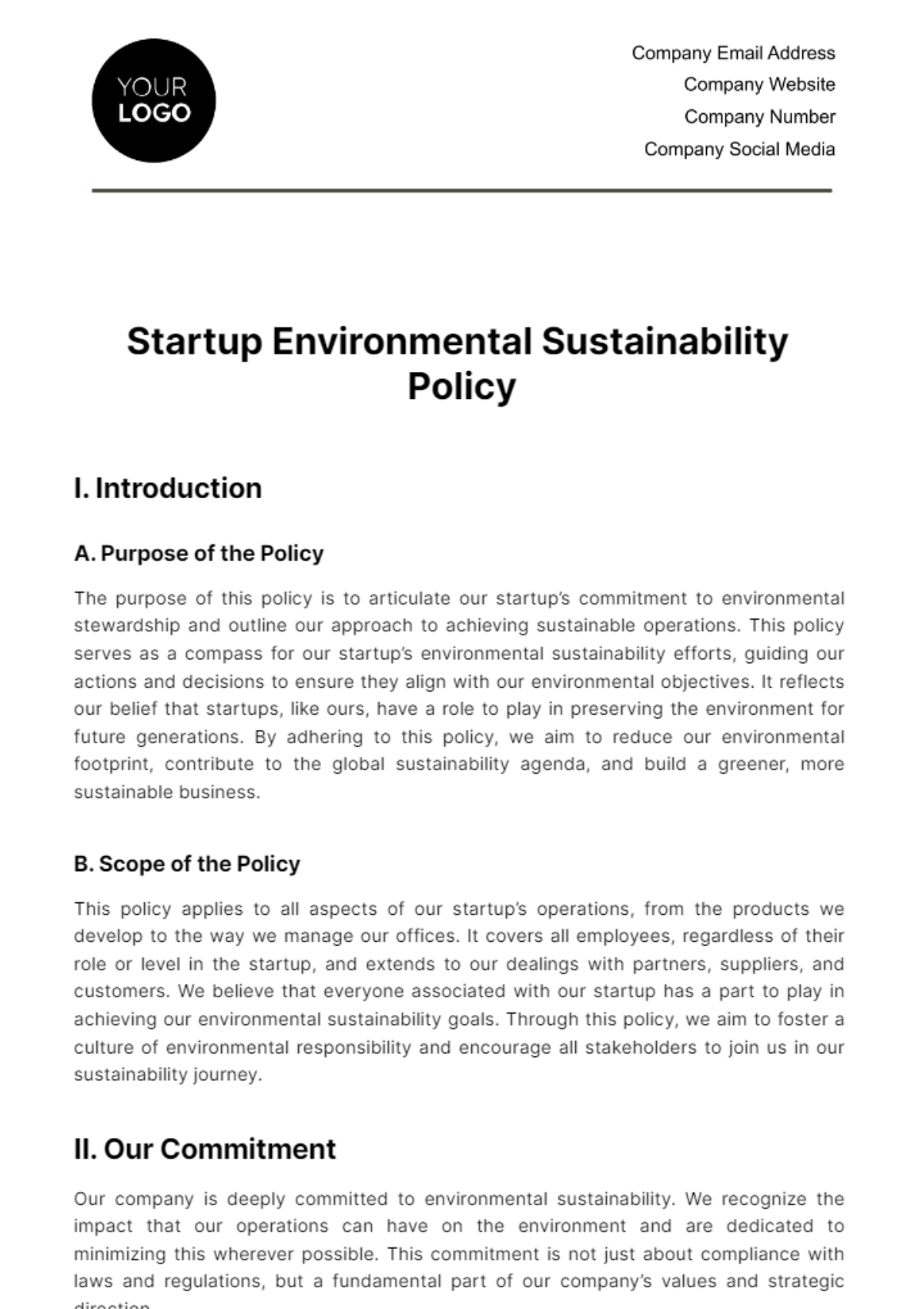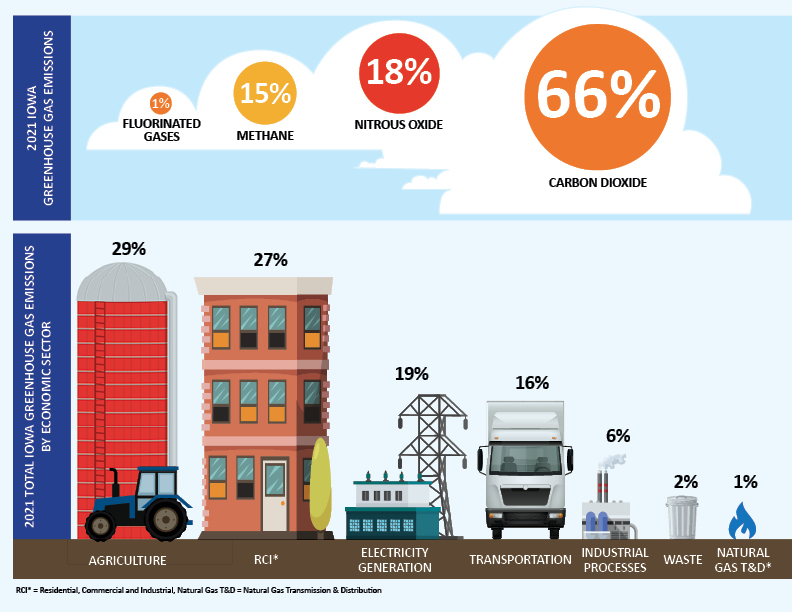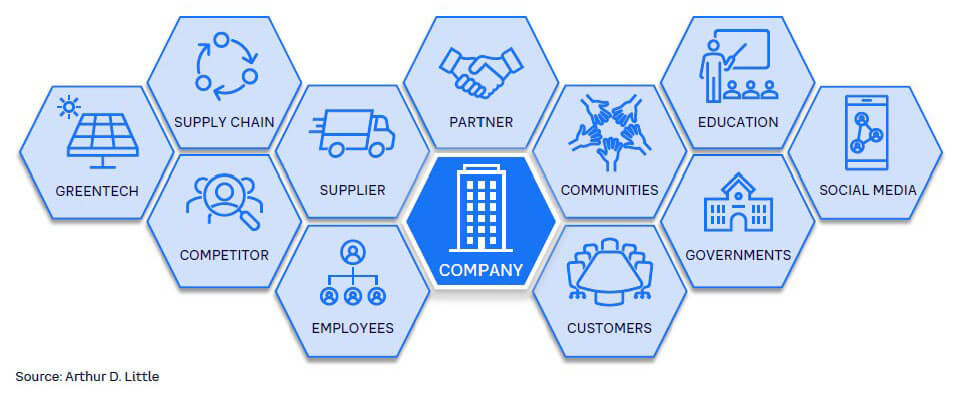Why Sustainability Matters for New Businesses
Environmental sustainability is a critical aspect of business operations for startups. As the world grapples with the challenges of climate change, environmental degradation, and social inequality, businesses are expected to play a vital role in promoting sustainability. Environmental sustainability for startups is no longer a nicety, but a necessity that can have numerous benefits, including cost savings, enhanced brand reputation, and compliance with regulations.
One of the primary advantages of environmental sustainability for startups is the potential for cost savings. By reducing energy consumption, water usage, and waste generation, businesses can lower their operational costs and improve their bottom line. For instance, a startup that invests in energy-efficient lighting and equipment can reduce its energy bills by up to 30%. Similarly, implementing recycling programs and reducing paper usage can lead to significant cost savings.
Environmental sustainability can also enhance a startup’s brand reputation and appeal to customers who share similar values. In today’s market, consumers are increasingly looking for businesses that prioritize sustainability and social responsibility. By incorporating environmental sustainability into their operations, startups can differentiate themselves from competitors and attract customers who are willing to pay a premium for sustainable products and services.
Furthermore, environmental sustainability is becoming a regulatory requirement for businesses. Governments around the world are implementing policies and regulations to promote sustainability and reduce environmental impact. Startups that fail to comply with these regulations can face fines, penalties, and reputational damage. By incorporating environmental sustainability into their operations, startups can ensure compliance with regulations and avoid potential risks.
In addition to these benefits, environmental sustainability can also be a key differentiator for startups in a competitive market. By prioritizing sustainability, startups can demonstrate their commitment to social responsibility and attract top talent, investors, and customers. In a market where consumers are increasingly looking for businesses that share their values, environmental sustainability can be a major competitive advantage.
Conducting a Sustainability Audit: Identifying Areas for Improvement
Conducting a sustainability audit is a crucial step for startups to identify areas for improvement and develop a comprehensive environmental sustainability strategy. A sustainability audit is a thorough assessment of a company’s environmental impact, including energy usage, water consumption, waste management, and supply chain impact. By conducting a sustainability audit, startups can identify areas where they can reduce their environmental footprint and improve their sustainability performance.
The process of conducting a sustainability audit typically involves several steps. First, startups should gather data on their energy usage, water consumption, and waste generation. This data can be collected from utility bills, water meters, and waste management records. Next, startups should assess their supply chain impact, including the environmental sustainability of their suppliers and vendors. This can be done by conducting surveys or audits of suppliers and vendors.
Once the data has been collected and analyzed, startups can identify areas for improvement and set realistic goals for reducing their environmental impact. For example, a startup may identify that their energy usage is high due to inefficient lighting and equipment. They can set a goal to reduce their energy usage by 20% by switching to energy-efficient lighting and equipment.
Startups can also use sustainability audit tools and frameworks to help them conduct a comprehensive sustainability audit. For example, the Global Reporting Initiative (GRI) provides a framework for sustainability reporting that can be used to conduct a sustainability audit. The GRI framework includes indicators for energy usage, water consumption, waste management, and supply chain impact, among other things.
By conducting a sustainability audit, startups can identify areas for improvement and develop a comprehensive environmental sustainability strategy. This can help them reduce their environmental impact, improve their sustainability performance, and enhance their brand reputation. Environmental sustainability for startups is not just a moral imperative, but also a business opportunity that can drive cost savings, innovation, and growth.
How to Develop a Comprehensive Sustainability Strategy
Developing a comprehensive sustainability strategy is crucial for startups to achieve environmental sustainability and reap its benefits. A well-crafted sustainability strategy can help startups reduce their environmental footprint, improve their brand reputation, and increase their competitiveness. To develop a comprehensive sustainability strategy, startups should follow a structured approach that includes setting clear goals, engaging stakeholders, and implementing sustainable practices.
Setting clear goals is the first step in developing a comprehensive sustainability strategy. Startups should define their sustainability vision, mission, and objectives, and establish key performance indicators (KPIs) to measure progress. The goals should be specific, measurable, achievable, relevant, and time-bound (SMART) and aligned with the company’s overall mission and values. For example, a startup may set a goal to reduce its greenhouse gas emissions by 20% within the next two years.
Engaging stakeholders is another critical component of a comprehensive sustainability strategy. Startups should identify their stakeholders, including employees, customers, suppliers, and investors, and engage them in the sustainability planning process. This can be done through surveys, focus groups, and workshops. Stakeholder engagement can help startups identify areas for improvement, build support for sustainability initiatives, and ensure that sustainability is integrated into the company’s overall strategy.
Implementing sustainable practices is the third step in developing a comprehensive sustainability strategy. Startups should identify areas for improvement and implement sustainable practices that reduce their environmental footprint. This can include reducing energy consumption, water usage, and waste generation, and promoting sustainable transportation options. Startups can also implement sustainable procurement practices, such as sourcing materials from sustainable suppliers and reducing packaging waste.
Integrating sustainability into the company’s overall mission and values is essential for a comprehensive sustainability strategy. Startups should ensure that sustainability is embedded in their culture and values, and that it is reflected in their policies, procedures, and practices. This can be done by including sustainability in the company’s mission statement, values, and policies, and by providing training and education to employees on sustainability.
By following these steps, startups can develop a comprehensive sustainability strategy that helps them achieve environmental sustainability and reap its benefits. Environmental sustainability for startups is not just a moral imperative, but also a business opportunity that can drive cost savings, innovation, and growth.
Reducing Energy Consumption and Greenhouse Gas Emissions
Reducing energy consumption and greenhouse gas emissions is a critical aspect of environmental sustainability for startups. By implementing sustainable practices and technologies, startups can significantly reduce their environmental footprint and contribute to a more sustainable future. In this section, we will discuss ways to reduce energy consumption and greenhouse gas emissions, including switching to renewable energy sources, increasing energy efficiency, and promoting sustainable transportation options.
Switching to renewable energy sources is one of the most effective ways to reduce greenhouse gas emissions. Startups can consider investing in solar panels, wind turbines, or geothermal energy systems to power their operations. For example, a startup can install solar panels on its rooftop to generate electricity and reduce its reliance on fossil fuels. Additionally, startups can explore renewable energy certificates (RECs) or carbon offsetting to compensate for their energy consumption.
Increasing energy efficiency is another way to reduce energy consumption and greenhouse gas emissions. Startups can implement energy-efficient lighting, HVAC systems, and equipment to reduce their energy consumption. For instance, a startup can replace traditional incandescent bulbs with LED bulbs, which consume significantly less energy and last longer. Additionally, startups can implement smart building technologies to optimize energy consumption and reduce waste.
Promoting sustainable transportation options is also essential for reducing greenhouse gas emissions. Startups can encourage employees to use public transportation, carpool, or bike to work. Additionally, startups can consider investing in electric or hybrid vehicles for company use. For example, a startup can provide electric vehicle charging stations for employees who drive electric vehicles.
Several startups have successfully reduced their energy consumption and greenhouse gas emissions by implementing sustainable practices and technologies. For instance, a startup in the tech industry reduced its energy consumption by 30% by switching to renewable energy sources and implementing energy-efficient lighting and HVAC systems. Another startup in the manufacturing industry reduced its greenhouse gas emissions by 25% by implementing sustainable transportation options and reducing waste.
By reducing energy consumption and greenhouse gas emissions, startups can contribute to a more sustainable future and enhance their brand reputation. Environmental sustainability for startups is not just a moral imperative, but also a business opportunity that can drive cost savings, innovation, and growth.
Implementing Sustainable Practices in the Workplace
Implementing sustainable practices in the workplace is a crucial step for startups to achieve environmental sustainability. By reducing paper usage, implementing recycling programs, and promoting sustainable procurement practices, startups can significantly reduce their environmental footprint and contribute to a more sustainable future. In this section, we will discuss tips on implementing sustainable practices in the workplace and emphasize the importance of employee engagement and education.
Reducing paper usage is one of the simplest ways to implement sustainable practices in the workplace. Startups can switch to digital documents and communications, use double-sided printing, and reduce paper usage in meetings and presentations. For example, a startup can implement a paperless policy for all internal communications and meetings, and encourage employees to use digital tools for note-taking and collaboration.
Implementing recycling programs is another effective way to reduce waste and promote sustainability in the workplace. Startups can set up recycling bins for paper, plastic, glass, and metal, and encourage employees to recycle their waste. Additionally, startups can compost food waste and reduce the amount of waste sent to landfills. For instance, a startup can implement a recycling program for all office supplies and materials, and encourage employees to participate in the program.
Promoting sustainable procurement practices is also essential for implementing sustainable practices in the workplace. Startups can source materials and supplies from sustainable suppliers, reduce packaging waste, and choose products with minimal environmental impact. For example, a startup can source office supplies from sustainable suppliers, reduce packaging waste by choosing products with minimal packaging, and choose products with minimal environmental impact.
Employee engagement and education are critical components of implementing sustainable practices in the workplace. Startups should educate employees on the importance of sustainability and encourage them to participate in sustainability initiatives. For instance, a startup can provide training and education on sustainability practices, encourage employees to participate in sustainability initiatives, and recognize and reward employees for their contributions to sustainability.
By implementing sustainable practices in the workplace, startups can reduce their environmental footprint, improve their brand reputation, and contribute to a more sustainable future. Environmental sustainability for startups is not just a moral imperative, but also a business opportunity that can drive cost savings, innovation, and growth.
Measuring and Reporting Sustainability Progress
Measuring and reporting sustainability progress is a crucial step for startups to track their environmental sustainability performance and make informed decisions. By setting key performance indicators (KPIs) and using sustainability reporting frameworks, startups can evaluate their progress towards sustainability goals and identify areas for improvement. In this section, we will discuss the importance of measuring and reporting sustainability progress and highlight the benefits of transparency and accountability.
Setting KPIs is essential for measuring sustainability progress. Startups should establish clear and measurable goals for sustainability performance, such as reducing energy consumption, water usage, or waste generation. KPIs should be specific, measurable, achievable, relevant, and time-bound (SMART) to ensure that they are effective in tracking progress. For example, a startup may set a KPI to reduce energy consumption by 20% within the next year.
Using sustainability reporting frameworks is also important for measuring and reporting sustainability progress. Frameworks such as the Global Reporting Initiative (GRI) and the Sustainability Accounting Standards Board (SASB) provide guidelines for reporting sustainability performance. Startups can use these frameworks to report their sustainability progress and provide stakeholders with a clear understanding of their environmental sustainability performance.
Transparency and accountability are critical components of measuring and reporting sustainability progress. Startups should be transparent about their sustainability performance and provide stakeholders with regular updates on their progress. This can be done through annual sustainability reports, quarterly updates, or regular social media posts. By being transparent and accountable, startups can build trust with stakeholders and demonstrate their commitment to environmental sustainability.
Measuring and reporting sustainability progress can also help startups identify areas for improvement and make informed decisions. By tracking their sustainability performance, startups can identify areas where they can improve and make changes to reduce their environmental impact. For example, a startup may discover that their energy consumption is higher than expected and make changes to reduce their energy usage.
Environmental sustainability for startups is not just a moral imperative, but also a business opportunity that can drive cost savings, innovation, and growth. By measuring and reporting sustainability progress, startups can demonstrate their commitment to environmental sustainability and build trust with stakeholders.
Overcoming Common Challenges to Sustainability
Implementing environmental sustainability for startups can be challenging, but there are several common obstacles that can be overcome with the right strategies. In this section, we will discuss common challenges to sustainability, including limited resources, competing priorities, and lack of expertise. We will also offer advice on how to overcome these challenges and stay committed to sustainability goals.
One of the most common challenges to sustainability is limited resources. Startups often have limited budgets and personnel, which can make it difficult to implement sustainability initiatives. However, there are several ways to overcome this challenge. For example, startups can start by implementing small, low-cost sustainability initiatives, such as reducing energy consumption or implementing recycling programs. Additionally, startups can seek out grants or funding opportunities that support sustainability initiatives.
Competing priorities are another common challenge to sustainability. Startups often have multiple priorities, including growing the business, increasing revenue, and improving customer satisfaction. However, sustainability should be a top priority for startups, as it can have a significant impact on the environment and the bottom line. To overcome this challenge, startups should integrate sustainability into their overall business strategy and make it a key performance indicator (KPI).
Lack of expertise is another common challenge to sustainability. Startups may not have the necessary expertise or knowledge to implement sustainability initiatives. However, there are several ways to overcome this challenge. For example, startups can hire sustainability experts or consultants who can provide guidance and support. Additionally, startups can seek out training and education programs that focus on sustainability.
Despite these challenges, many startups have successfully implemented sustainability initiatives and achieved significant benefits. For example, a startup in the tech industry reduced its energy consumption by 30% by implementing a sustainability program. Another startup in the manufacturing industry reduced its waste generation by 25% by implementing a recycling program.
Environmental sustainability for startups is not just a moral imperative, but also a business opportunity that can drive cost savings, innovation, and growth. By overcoming common challenges to sustainability, startups can achieve significant benefits and contribute to a more sustainable future.
Scaling Sustainability as Your Startup Grows
As your startup grows, it’s essential to scale sustainability initiatives to maintain a strong sustainability culture and continue to reduce environmental impact. Scaling sustainability requires intentional planning, integration, and communication. In this section, we will discuss the importance of scaling sustainability as your startup grows, including integrating sustainability into new products and services, expanding sustainability initiatives to new locations, and maintaining a strong sustainability culture.
Integrating sustainability into new products and services is crucial for maintaining a strong sustainability culture. As your startup grows, new products and services may be developed, and it’s essential to ensure that these products and services are sustainable. This can be achieved by incorporating sustainability into the product development process, conducting life cycle assessments, and designing products and services that are environmentally friendly.
Expanding sustainability initiatives to new locations is also essential for scaling sustainability. As your startup grows, new locations may be established, and it’s essential to ensure that these locations are sustainable. This can be achieved by implementing sustainable practices, such as energy-efficient lighting and HVAC systems, reducing water consumption, and implementing recycling programs.
Maintaining a strong sustainability culture is critical for scaling sustainability. As your startup grows, it’s essential to maintain a strong sustainability culture by continuing to educate and engage employees, stakeholders, and customers on sustainability initiatives. This can be achieved by providing regular updates on sustainability progress, recognizing and rewarding employees for their contributions to sustainability, and incorporating sustainability into the company’s overall mission and values.
Several startups have successfully scaled sustainability as they grew, and their experiences offer valuable lessons for other startups. For example, a startup in the tech industry scaled its sustainability initiatives by integrating sustainability into its product development process, expanding its sustainability initiatives to new locations, and maintaining a strong sustainability culture.
Environmental sustainability for startups is not just a moral imperative, but also a business opportunity that can drive cost savings, innovation, and growth. By scaling sustainability as your startup grows, you can maintain a strong sustainability culture, reduce environmental impact, and contribute to a more sustainable future.





